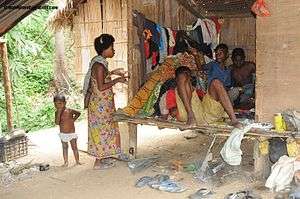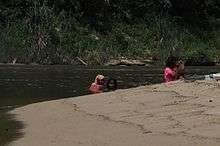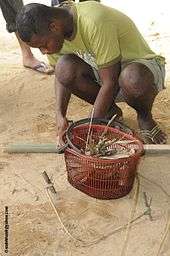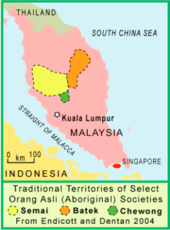Batek people
The Batek (or Bateq) are an indigenous people (numbering about 1,519 in 2000[2]) who live in the rainforest of peninsular Malaysia. As a result of encroachment, they now primarily inhabit the Taman Negara National Park. They are nomadic hunters and gatherers, so the exact location of their settlements change within the general confines of the area that they inhabit.[3]
 A Batek family. | |
| Total population | |
|---|---|
| 1,359 (2010)[1] | |
| Regions with significant populations | |
| Languages | |
| Batek language, Malay language | |
| Religion | |
| Traditional religion and significant adherents of Islam, Christianity or Buddhism. | |
| Related ethnic groups | |
| Jahai people, Minriq people |
The common phrase used to refer to them, 'orang asli', signifies a diverse group of which the Batek tribe is a part. It means 'original people' in Malay and was probably first used to identify these people by Austronesian-speaking settlers who arrived by boat from the islands of Southeast Asia. The Malay Srivijaya empire came in contact with the Negrito. Historically they traded with the local populations while other times they were subjected to exploitation, raids, slavery, paying tributes to the Malays. For more than a thousand years, some Negrito tribes from the southern forests were enslaved and exploited until modern times while others remain in isolation and avoided contact.[4]
The Batek people were first documented by Europeans in 1878, when explorer-naturalist Nicholai Miklukho-Maklai of Russia wrote about them.[5]
Until about 1970 much of inland peninsular Malaysia was difficult to reach for the purposes of logging, so the Batek were widespread throughout that region. Since it is now possible to harvest the trees in that region, the Batek are largely confined to Taman Negara National Park and the surrounding region.[6]
Population
The dynamics of the Batek population in Malaysia:-
| Year | 1960[7] | 1965[7] | 1969[7] | 1974[7] | 1980[7] | 1993[8] | 1996[7] | 2000[9] | 2003[9] | 2004[10] | 2010[1] |
|---|---|---|---|---|---|---|---|---|---|---|---|
| Population | 530 | 339 | 501 | 585 | 720 | 960 | 960 | 1,519 | 1,255 | 1,283 | 1,359 |
Language
The Batek language belongs to the Eastern Jahaic sub-branch of Aslian languages which is part of a wider Mon–Khmer language family.[11] Batek's closest linguistic relatives is Mintil and Jahai and distantly related to other Aslian languages. Despite being a small language, it has quite a number of dialects namely Teq, Iga, Deq and Nong, with the latter two probably considered distinct enough to be separate languages. Batek is mostly an oral language with few written records, but it is usually written in a modified Latin alphabet.
Way of life

The Batek normally live in familial groups, in tents and lean-tos, with about 10 families forming an encampment. Each encampment generally has control of the land immediately around it, but since the Batek do not believe in the concept of private land ownership, the encampment considers it to be the caretaker of the land, rather than its owner. Also since they are nomadic once most of the usable wild plant resources have been depleted from a given location they will move to another spot, within their habitat.[12]
The Batek economy is very complex, with some things such as land, having no right of ownership. Somethings where there is a personal property right, but social norms dictate that it be shared with the entire society such as food that is found by foraging. There are some things that are considered personal property, such as a man's blowgun, or a women's hair combs.[13]
Batek are a peaceful society. If a member of the group has a conflict with another member of the group they will discuss the matter privately. If that does not end the disagreement, each will publicly share their side of the argument in an attempt to have other members of the camp suggest a resolution. Since each adult member of the camp is equal, there is no internal leader or adjudication system so one or both of the aggrieved parties will leave the camp until cooler heads prevail.[12][14]
Sharing
| Part of a series on |
| Economic, applied, and development anthropology |
|---|
|
Provisioning systems |
|
Case studies
|
| Social and cultural anthropology |

It is a moral obligation for Batek to share food they have acquired. Normally the person who harvests the food item will first give to their immediate family, then their extended family and finally the rest of the camp. If everyone is giving to everyone else, a family who is down on their luck will still have food to eat, although not as much as if they harvested it themselves.
Since the hunting and butchering of meat causes a large amount of food to enter the camp at once, there is a more formal and ritualistic way of dividing it, for example with a monkey, first the members of the hunting party eat the offal and tail, because they cook the fastest, then the cooked meat is divided into about 13 parts, so that each family in the camp gets some, with the portions adjusted according to the size of the family.
The Batek do not consider this sharing of resources to be an act of kindness, they believe that all food items belong to the forest, so that the person who happens to be in possession of food has a moral obligation to share it. Since the dwellings are open, it is impossible to hoard food without others knowing about it. Since selfishness is prohibited, it would not be considered stealing for another member of the camp to take food away from someone who was hoarding, if the taker was hungry.[15]
They feel an obligation to give when they are asked for something. This feeling is reinforced by their belief that to refuse a request can cause super-natural harm to the person who was refused and by their knowledge that this will evoke the anger of the community at the offender.
Although personal possessions like radios and tobacco belong exclusively to the person who acquired them, it is common for those items to be lent or sometimes even borrowed without the owner's knowledge. The Batek believe that if a requested favor is refused, the person who was turned down, will likely suffer misfortune, and when the misfortune happens everyone in the camp will be angry at the person who was unkind.
There are two more practical reasons that sharing and kindness are widespread in the Batek community, first each man has a blowgun, used mainly for hunting, so if all in the group did not get along, someone could be subject to violence. Also the rain forest is very hot and damp so keeping things long-term is impractical, food will rot and hardware will rust if it is not used frequently.[14]
Modern challenges

External disagreements become a little more tricky. Since they do not have leaders or a military, the Batek are generally at the mercy of the Malaysian Government. Malaysia does not recognise Batek sovereignty, so during the 20th century the Government gradually encroached on the Batek land to use it for logging and farming.[16] Since the 1960s the Government has encouraged the Batek to live in Pos Lebir and become non-nomadic farmers. Most Batek are unwilling to settle in Pos Lebir because it has not been dedicated to the Batek; they would have to leave there if the Government asked and they would lose their nomadic lifestyle and their religion. One of the Batek summed up the situation by saying: “We Batek are rich if we have a cooking pot, digging stick, bush-knife, lighter, tobacco, salt and fishing pole. Also a man is sad if he doesn't have a blowpipe. We only want four or five sarongs, we don't need trousers. If we live here (in Pos Lebir), we need money, if we have money we buy a lot. But if we have no money, no problem, we reject possessions. When we live in the forest, we don't need them. We can dig tubers. If someone doesn't have food, others give it as in the old days.”[17]
2019 measles outbreak
In 2019, the Batek people in Kuala Koh Village of Kelantan was affected by a mysterious disease which took the lives of more than 15 people from the community.[18][19] The disease was firstly thought as a mysterious illness for nearly a month before being finally confirmed as measles by the Malaysian Health Ministry following growing national attention on the outbreak.[20][21] The cause of the spread in the community is due to low coverage of MMR immunisation which is attributed to the relatively low immunisation rate among the community with their nomadic lifestyle with findings by Malaysian Health Ministry found that although 61.5% of the villagers received their first measles, mumps, and rubella (MMR) shots, only 30% of them had their follow-up shots.[22]
Settlement areas

Some of the settlements that the Bateq people are located includes:-
- Kampung Orang Asli Dedari, Kuala Tahan, Taman Negara, Pahang[23]
- Kampung Kuala Sat, Kuala Tahan, Taman Negara, Pahang[24]
- Kuala Kemiang, Kuala Tahan, Taman Negara, Pahang[24]
- Sungai Cheka, Kuala Lipis, Pahang[25]
- Semetong, Pahang[26]
- Merapoh, Kampung Bercah, Pelubi, Pahang[27]
- Kampung Orang Asli Kuala Koh, Kelantan[28]
- Kampung Pasir Linggi, Pos Lebir, Gua Musang, Kelantan[29]
- Kampung Aring 5, Gua Musang, Kelantan[30]
- Pasir Lenggi, Ulu Kelantan, Kelantan[31]
- Kampung Sungai Berua, Kenyir Lake, Hulu Terengganu District, Terengganu[24]
- Kampung Sungai Sayap, Besut District, Terengganu[24]
See also
- Semang
- Mani people
References
- Kirk Endicott (2015). Malaysia's Original People: Past, Present and Future of the Orang Asli. NUS Press. p. 2. ISBN 978-99-716-9861-4.
- "Orang Asli Population Statistics". Center for Orang Asli Concerns. Retrieved 2008-02-12.
- Bonta, Bruce D. Peaceful Peoples: an Annotated Bibliography ISBN 0-8108-2785-9. Metuchen NJ: Scarecrow, 1993 Page 29-31
- Archives of the Chinese Art Society of America
- Endicott, Kirk. “The Batek of peninsular Malaysia.” The Cambridge Encyclopedia of Hunters and Gatherers ISBN 0-521-57109-X. 2004 Page 298
- Lye, Tuck-Po. Changing Pathways: Forest Degradation and the Batek of Pahang Malaysia ISBN 0-7391-0650-3. Lanham, MD: Lexington, 2004 Page 2-4
- Nobuta Toshihiro (2009). "Living On The Periphery: Development and Islamization Among Orang Asli in Malaysia" (PDF). Center for Orang Asli Concerns. Retrieved 2017-10-27.
- Colin Nicholas (2000). The Orang Asli and the Contest for Resources. Indigenous Politics, Development and Identity in Peninsular Malaysia (PDF). Center for Orang Asli Concerns & International Work Group for Indigenous Affairs. ISBN 87-90730-15-1. Retrieved 2017-10-27.
- "Basic Data / Statistics". Center for Orang Asli Concerns. Retrieved 2017-10-27.
- Alberto Gomes (2004). Modernity and Malaysia: Settling the Menraq Forest Nomads. Routledge. ISBN 11-341-0076-0.
- www.ethnologue.com : Batek
- Bonta, Bruce D. Peaceful Societies. 2005. January 12, 2006
- Endicott, Kirk. “Property, Power and Conflict Among the Batek of Malaysia.” Hunters and gatherers 2: Property Power and Ideology ISBN 0-85496-735-4. 1988 Page 117
- Endicott, Kirk. “Property, Power and Conflict Among the Batek of Malaysia.” Hunters and gatherers 2: Property Power and Ideology ISBN 0-85496-735-4. 1988 Page 119-120
- Endicott, Kirk. “Property, Power and Conflict Among the Batek of Malaysia.” Hunters and gatherers 2: Property Power and Ideology ISBN 0-85496-735-4. 1988 Page 116-118
- James Whitlow Delano (3 August 2011). "How Biofuels Are Destroying Indigenous Communities in Malaysia". The Atlantic. Retrieved 2016-12-14.
- Endicott, Kirk. “The Batek of peninsular Malaysia.” The Cambridge Encyclopedia of Hunters and Gatherers ISBN 0-521-57109-X. 2004
- Jia Vern Tham (10 June 2019). "14 Orang Asli Have Died In Kelantan Within A Month. Here's All You Need To Know". Says.com. Archived from the original on 27 August 2019. Retrieved 27 August 2019.
- Alyssa J. Oon (17 June 2019). "A Measles Outbreak Is The Cause of 15 Orang Asli Deaths In Kelantan". Says.com. Archived from the original on 27 August 2019. Retrieved 27 August 2019.
- Hannah Ellis-Petersen (11 June 2019). "Malaysia's last indigenous nomadic tribe threatened by deadly mystery illness". The Guardian. Archived from the original on 27 August 2019. Retrieved 27 August 2019.
- Joseph Kaos Jr. (17 June 2019). "Health Minister: Disease affecting Kampung Kuala Koh is measles". The Star. Retrieved 27 August 2019.
- Debra Chong (17 June 2019). "Health minister verifies Kuala Koh Orang Asli hit by measles outbreak". The Malay Mail. Archived from the original on 27 August 2019. Retrieved 27 August 2019.
- Kisho Kumari Sucedaram (16 March 2016). "Taman Negara Batek tribe rooted in simple existence". The Malay Mail Online. Retrieved 2017-04-10.
- Salasiah Che Lah (2014). "Ethnic Tourism: A Case Study of Language and Culture Preservation of the Bateq Indigenous Group of Orang Asli in Peninsular Malaysia" (PDF). EDP Sciences. Retrieved 2017-04-10.
- Ahmad Salludin Yeop Mat Ali (1974). Sistem kekeluargaan orang Batek Sungai Cheka, Kuala Lipis, Pahang. Jabatan Antropologi dan Sosiologi, Universiti Malaya.
- Aizan Mohd. Yusof (1974). Perubahan sosial di kalangan kelompok Bateq-Ndong, (Negritos) Semetong, Pahang. Jabatan Antropologi dan Sosiologi, Universiti Malaya.
- Loh Foon Fong (7 June 2016). "Long journey to land recognition". The Star Online. Retrieved 2017-04-10.
- Anita Abu Hasan (27 January 2014). "Jakoa terima aduan Orang Asli". Sinar Harian. Archived from the original on 11 April 2017. Retrieved 2017-04-10.
- "Persekolahan 462 pelajar Orang Asli tertangguh". Utusan. 7 January 2017. Archived from the original on 11 April 2017. Retrieved 2017-04-10.
- Aimuni Tuan Lah (25 August 2015). "Kesihatan Orang Asli tidak diabai". Utusan. Archived from the original on 11 April 2017. Retrieved 2017-04-10.
- Khadizan bin Abdullah & Abdul Razak Yaacob (1974). Pasir Lenggi: A Batek Negrito esettlement Area in Ulu Kelantan(Report No.3. Social Anthropology Section. School of Comparative Social Sciences Universiti Sains Malaysia.Pulau Pinang: Universiti Sains Malaysia.
Further reading
- Kirk M. Endicott and Karen L. Endicott, "The Headman Was a Woman: The Gender Egalitarian Batek of Malaysia" (Waveland, 2008).
External links
- Rebecca Bailey (26 February 2008), Peaceful, egalitarian hunter-gatherers retain traditions despite homeland loss, Dartmouth College Office of Public Affairs, archived from the original on 20 November 2017, retrieved 14 December 2016
- http://projekt.ht.lu.se/rwaai RWAAI (Repository and Workspace for Austroasiatic Intangible Heritage)
- http://hdl.handle.net/10050/00-0000-0000-0003-66FE-9@view Batek in RWAAI Digital Archive
- Personal experience of volunteer working with Batek people
| Wikimedia Commons has media related to Bateq people. |